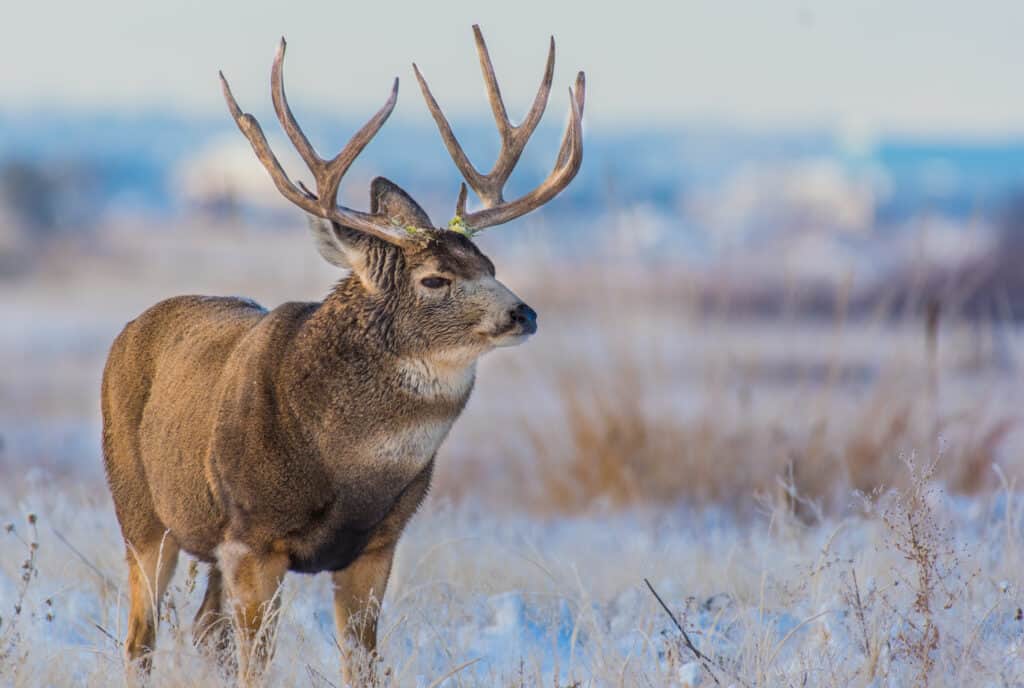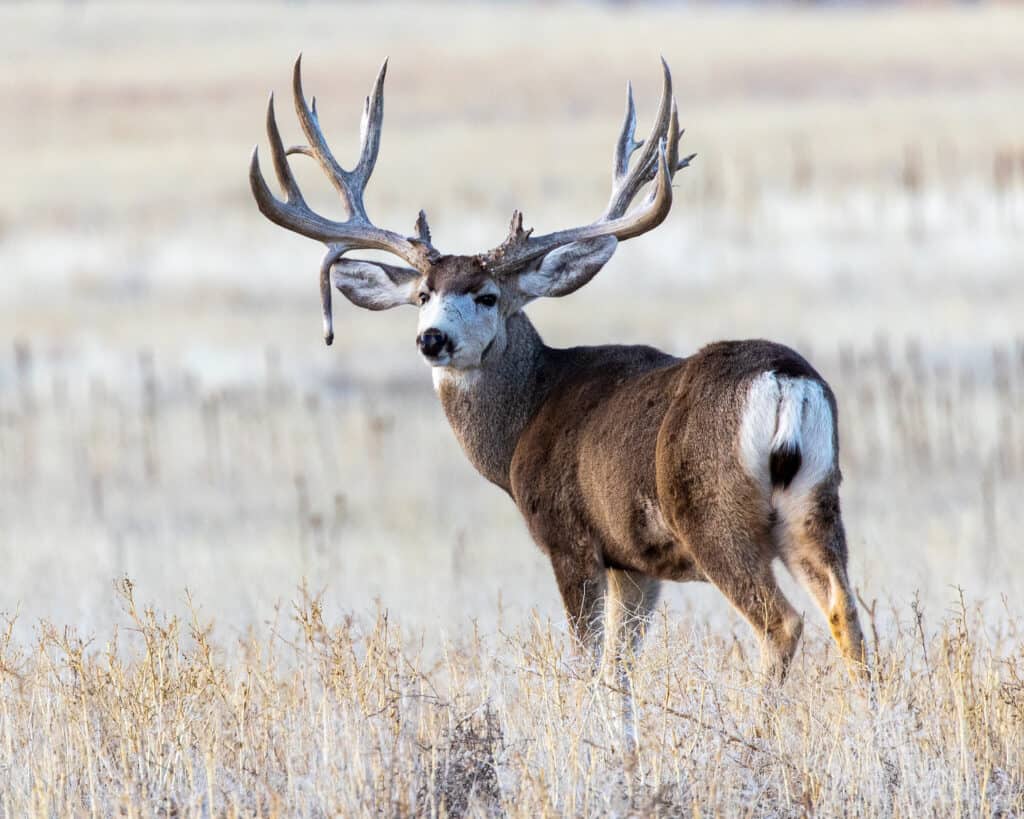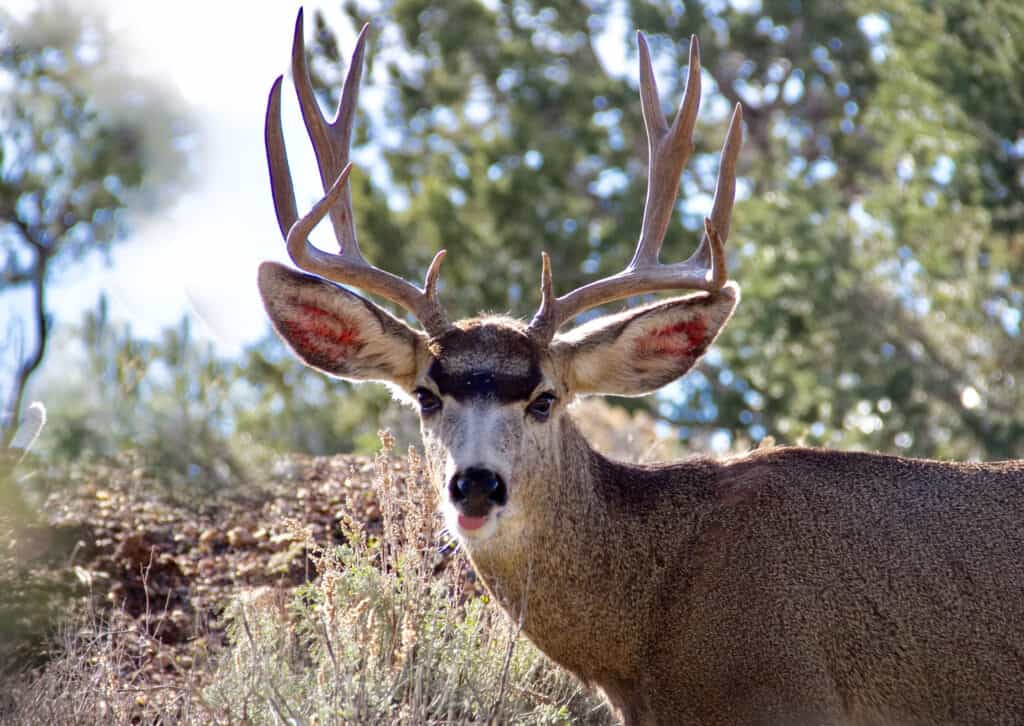Many different species and subspecies of deer live across North America. Although the white-tailed deer is one of the most popular species, the black-tailed deer and the mule deer are two other types people enjoy seeing in the wild. Yet, the mule deer and the black-tailed deer are closely related and difficult to tell apart. So, how can you tell the difference between a mule deer vs black-tailed deer? Don’t fret. We’ll provide several different ways to tell these animals apart!
Comparing a Mule Deer and a Black-Tailed Deer

The mule deer has a long, thin tail that is mostly white and ends in a black tip.
©iStock.com/Kerry Hargrove
| Mule Deer | Black-tailed Deer | |
|---|---|---|
| Size | Weight: 95-330 lbs Height: 2.8-3.8ft Length: 4-7 ft | Weight: 75-225 lbs Height: 2-3.7 ft Length: 4-5.5 ft |
| Species | – Odocoileus hemionus – Several subspecies, including the black-tailed deer | – Odocoileus hemionus columbianus or the Odocoileus hemionus sitkensis – Subspecies of the mule deer |
| Morphology | – Thin, long tail – Tail is mainly white with a black tip – Mostly white hindquarters – Antlers that fork off the main beam – Large ears from which they get their name | – Wider tail than a mule deer – Have a black tail with a white underside – Their tail is not as bushy as a white-tailed deer – Antlers grow off of the main beam and then split into two points – Reddish-brown coat in the summer fades into a dark brown and gray color in the fall and winter |
| Range | – British Columbia, Alberta, and Saskatchewan in Canada – Western half of the U.S. – Northern Mexico and Baja California | – Pacific Coast of North America – California, Oregon, Washington, and Alaska in the U.S. – British Columbia in Canada |
| Diet | – Forbs, shrubs, trees, grass – Prickly lettuce, Gambel oak, quaking aspen, rice grass, goldeneye | – Forbs, lichens, grasses, fruit – Ferns, huckleberry, blackberries, apples, cranberry, elderberry, and more |
The Key Differences Between a Mule Deer vs Black-Tailed Deer
The most significant differences between a mule deer and a black-tailed deer lie in their size and the morphology of their tails. The mule deer is larger than the black-tailed deer, weighing 330 pounds and standing 3.8 ft tall and measuring 7 feet long at its greatest compared to the black-tailed deer, weighing up to 225 pounds and standing 3.7 feet tall, and measures 4-5.5. ft tall.
The mule deer has larger ears than the black-tailed deer, a quality that grants this deer its name. Yet, the mule deer has a long, thin tail that is mostly white and ends in a black tip, while the black-tailed deer has a wider tail that is black when hanging down.
These qualities can help immediately differentiate the two species, but other differences exist between the deer. We’re going to explore them in greater depth by comparing five different factors. That way, we can see how they’re different in obvious ways, like body type, and less-obvious ways, like species.
Mule Deer vs Black-Tailed Deer: Size

The black-tailed deer reaches a weight of 225 pounds, stands between 2 and 3.7 feet tall, and grows between 4 and 5.5 feet long.
©iStock.com/Kerry Hargrove
The mule deer has a larger maximum size than the black-tailed deer. The average mule deer will grow between 95 and 330 pounds in weight, 2.8-3.9 feet in height, and between 4 and 7 feet in length. Meanwhile, the black-tailed deer only reaches a weight of 225 pounds, stands between 2 and 3.7 feet tall, and grows between 4 and 5.5 feet long.
However, these measures depend on which subspecies of black-tailed deer you encounter. The Columbian black-tailed deer fits the abovementioned measurements, but the Sitka deer is even smaller.
Mule Deer vs Black-Tailed Deer: Species

The black-tailed deer is a subspecies of the mule deer.
©iStock.com/twildlife
The mule deer’s scientific name is Odocoileus hemionus. However, the species has a variety of subspecies, including the black-tailed deer. Meanwhile, the black-tailed deer is either Odocoileus hemionus columbianus or the Odocoileus hemionus sitkensis.
These are two subspecies of the mule deer, sharing some but not all qualities with the main stem of the species.
Mule Deer vs Black-Tailed Deer: Morphology

The black-tailed deer are found along the Pacific Coast of North America.
©iStock.com/Jeff Edwards
The mule deer is known for having exceptionally large ears that resemble those of a mule. The black-tailed deer has very similar ears. Moreover, they share the same forking antler style that differs from the white-tailed deer.
Yet, mule deer have very different tails compared with black-tailed deer. The mule deer has a white rump with a small, thin white tail tipped in black. However, the black-tailed deer has a thick, puffy, black tail.
Mule Deer vs Black-Tailed Deer: Range

The mule deer is most common throughout the western half of the United States.
©iStock.com/Tiago_Fernandez
The mule deer and the black-tailed deer have different ranges. The mule deer is most common throughout the western half of the United States. They also live in British Columbia, Alberta, and Saskatchewan in Canada. Their range extends south as well. These deer can be found in northern Mexico along with Baja California.
The black-tailed deer has a distinct range too. These deer are found along the Pacific Coast of North America. They live in Alaska in the U.S., British Columbia in Canada, California, Oregon, and Washington State in the continental United States. However, black-tailed deer don’t have a range throughout most of Alaska.
The black-tailed deer has a much smaller range than the mule deer, even though they overlap in some areas.
Mule Deer vs Black-Tailed Deer: Diet

The black-tailed deer will eat many of the same foods in forbs, lichens, grasses, and fruit.
©iStock.com/Christina Radcliffe
The diet of the mule deer and the black-tailed deer is probably different due to each animal’s range rather than their preferences. The mule deer is known for eating forbs, shrubs, trees, and grass. Specifically, they’ll eat prickly lettuce, Gambel oak, quaking aspen, rice grass, goldeneye, and a wide variety of other foods.
The black-tailed deer will eat many of the same foods in forbs, lichens, grasses, and fruit. Their favorite meals are ferns, huckleberry, blackberries, apples, cranberry, elderberry, and more. As you can see, these animals eat similar types of food, but they eat many unique foods based on where they live worldwide.
Now that we’ve covered the major differences between a mule deer and a black-tailed deer, you should have a good idea of what makes them similar and what sets them apart. The easiest way to tell them apart is by their size and tails more than anything else.
Up Next:
- Fallow Deer vs Whitetail Deer
- Deer vs Reindeer: What Are 8 Key Differences?
- White-Tailed Deer vs Black-Tailed Deer: What Are the Differences?
- Mule Deer vs White-tail: 5 Key Differences Explained
The photo featured at the top of this post is ©
Sources
- JSTOR, Available here: https://www.jstor.org/stable/3504024
- National Wildlife Federation, Available here: https://www.nwf.org/Educational-Resources/Wildlife-Guide/Mammals/Mule-Deer
- State of Alaska Department of Fish and Game, Available here: https://www.adfg.alaska.gov/index.cfm?adfg=muledeer.main
- Mule Deer Foundation, Available here: https://muledeer.org/mule-deer-black-tailed-facts-biology/#:~:text=Mule%20deer%20are%20distributed%20throughout,the%20Canadian%20provinces%20of%20Saskatchewan%2C
Thank you for reading! Have some feedback for us? Contact the AZ Animals editorial team.






